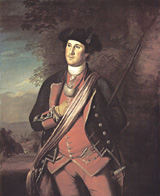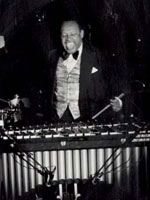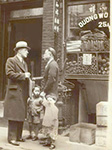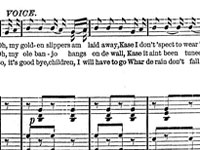1. During World War I, New York City audiences (if they knew the language of the performance) could attend patriotic musicals with titles like ____ War Brides and ____ Martyrs of America. What ethnic group fills in the blanks?
a. Jewish
 From the late 1880s to around 1940, Yiddish-language theatre found a home in New York City—as did the wave of Jewish immigrants who brought the performance form to the U.S. Fleeing persecution in Russia, these immigrants, whether they chose to be performing artists or audience members, developed a unique theatre culture. Unlike the short variety acts of contemporary vaudeville, Yiddish theatre presented full-evening-length plays, accompanied by music or broken up with song-and-dance numbers. Plays adapted popular works by authors like Shakespeare and Anton Chekhov, drew from folklore and folk customs, and/or commented on recent events in the U.S. and abroad. Some addressed issues of assimilation, such as intermarriage and generational gaps, while others praised the virtues of the immigrants' adopted country—as did the musicals mentioned above.
From the late 1880s to around 1940, Yiddish-language theatre found a home in New York City—as did the wave of Jewish immigrants who brought the performance form to the U.S. Fleeing persecution in Russia, these immigrants, whether they chose to be performing artists or audience members, developed a unique theatre culture. Unlike the short variety acts of contemporary vaudeville, Yiddish theatre presented full-evening-length plays, accompanied by music or broken up with song-and-dance numbers. Plays adapted popular works by authors like Shakespeare and Anton Chekhov, drew from folklore and folk customs, and/or commented on recent events in the U.S. and abroad. Some addressed issues of assimilation, such as intermarriage and generational gaps, while others praised the virtues of the immigrants' adopted country—as did the musicals mentioned above.
2. In 1852, a 42-member opera troupe arrived in the U.S. After giving successful performances to immigrants from its country of origin, it traveled to New York City, where non-immigrants panned its performances. Where did the troupe come from?
d. China
 In 1852, the Tong Hook Tong Dramatic Company arrived in California, following the stream of Chinese immigrants who had come to the state with the 1848 gold rush. Greeted warmly by immigrant audiences, they accepted a contract to perform in New York City. In New York, they discovered the contract was a scam, and secured their own theatre space, performing for New Yorkers independently. Chinese opera bears little resemblance to European opera, and even less to the "Oriental" image of China then popular on the mainstream stage. Confused by what they were seeing, New Yorkers rejected genuine Chinese theatre that did not match up with contemporary media stereotypes.
In 1852, the Tong Hook Tong Dramatic Company arrived in California, following the stream of Chinese immigrants who had come to the state with the 1848 gold rush. Greeted warmly by immigrant audiences, they accepted a contract to perform in New York City. In New York, they discovered the contract was a scam, and secured their own theatre space, performing for New Yorkers independently. Chinese opera bears little resemblance to European opera, and even less to the "Oriental" image of China then popular on the mainstream stage. Confused by what they were seeing, New Yorkers rejected genuine Chinese theatre that did not match up with contemporary media stereotypes.
3. In the 1960s and 1970s, a grassroots theatre movement, beginning in efforts to educate migrant farmers and encourage them to form unions, took off, spreading across the United States. Which minority group did this movement represent?
c. Chicanos
 In 1965, Luis Valdez, the son of Chicano migrant farm workers, founded the theatrical company El Teatro Campesino. El Teatro Campesino took theatrical performances—often without props, sets, or written scripts—directly to the camps of migrant farm workers. In its performances, the company sought to inspire farm workers to form a farm workers' union, but it also performed pieces based on Mexican popular theatre: corridas (dramatized ballads), peladitos (comic skits with an underdog protagonist), and religious pageants.
In 1965, Luis Valdez, the son of Chicano migrant farm workers, founded the theatrical company El Teatro Campesino. El Teatro Campesino took theatrical performances—often without props, sets, or written scripts—directly to the camps of migrant farm workers. In its performances, the company sought to inspire farm workers to form a farm workers' union, but it also performed pieces based on Mexican popular theatre: corridas (dramatized ballads), peladitos (comic skits with an underdog protagonist), and religious pageants.
El Teatro Campesino's success led to the growth of a national Chicano theatre movement, which peaked in the 1970s.
4. In the late 1910s and the 1920s, record companies including Okeh, Paramount, Vocalion, and Columbia began releasing records by performers from which minority group?
c. African Americans
 Prior to the Great Migration of the early 20th century, when African Americans came north in search of a better life, major record companies released African American music, but only as performed by white performers. Sensing the potential for a new market, the companies began to record African American performers and release their music on special labels targeted at African American audiences. Called "race records," these records were later marketed to white audiences as well. African Americans also established their own companies to distribute records—the first African American owned label, Black Swan, was established in 1921. Many styles of music associated with race records would later be recategorized as "rhythm and blues."
Prior to the Great Migration of the early 20th century, when African Americans came north in search of a better life, major record companies released African American music, but only as performed by white performers. Sensing the potential for a new market, the companies began to record African American performers and release their music on special labels targeted at African American audiences. Called "race records," these records were later marketed to white audiences as well. African Americans also established their own companies to distribute records—the first African American owned label, Black Swan, was established in 1921. Many styles of music associated with race records would later be recategorized as "rhythm and blues."

 From the late 1880s to around 1940, Yiddish-language theatre found a home in New York City—as did the wave of Jewish immigrants who brought the performance form to the U.S. Fleeing persecution in Russia, these immigrants, whether they chose to be performing artists or audience members, developed a unique theatre culture. Unlike the short variety acts of contemporary vaudeville, Yiddish theatre presented full-evening-length plays, accompanied by music or broken up with song-and-dance numbers. Plays adapted popular works by authors like Shakespeare and Anton Chekhov, drew from folklore and folk customs, and/or commented on recent events in the U.S. and abroad. Some addressed issues of assimilation, such as intermarriage and generational gaps, while others praised the virtues of the immigrants' adopted country—as did the musicals mentioned above.
From the late 1880s to around 1940, Yiddish-language theatre found a home in New York City—as did the wave of Jewish immigrants who brought the performance form to the U.S. Fleeing persecution in Russia, these immigrants, whether they chose to be performing artists or audience members, developed a unique theatre culture. Unlike the short variety acts of contemporary vaudeville, Yiddish theatre presented full-evening-length plays, accompanied by music or broken up with song-and-dance numbers. Plays adapted popular works by authors like Shakespeare and Anton Chekhov, drew from folklore and folk customs, and/or commented on recent events in the U.S. and abroad. Some addressed issues of assimilation, such as intermarriage and generational gaps, while others praised the virtues of the immigrants' adopted country—as did the musicals mentioned above. In 1852, the Tong Hook Tong Dramatic Company arrived in California, following the stream of Chinese immigrants who had come to the state with the 1848 gold rush. Greeted warmly by immigrant audiences, they accepted a contract to perform in New York City. In New York, they discovered the contract was a scam, and secured their own theatre space, performing for New Yorkers independently. Chinese opera bears little resemblance to European opera, and even less to the "Oriental" image of China then popular on the mainstream stage. Confused by what they were seeing, New Yorkers rejected genuine Chinese theatre that did not match up with contemporary media stereotypes.
In 1852, the Tong Hook Tong Dramatic Company arrived in California, following the stream of Chinese immigrants who had come to the state with the 1848 gold rush. Greeted warmly by immigrant audiences, they accepted a contract to perform in New York City. In New York, they discovered the contract was a scam, and secured their own theatre space, performing for New Yorkers independently. Chinese opera bears little resemblance to European opera, and even less to the "Oriental" image of China then popular on the mainstream stage. Confused by what they were seeing, New Yorkers rejected genuine Chinese theatre that did not match up with contemporary media stereotypes. In 1965, Luis Valdez, the son of Chicano migrant farm workers, founded the theatrical company El Teatro Campesino. El Teatro Campesino took theatrical performances—often without props, sets, or written scripts—directly to the camps of migrant farm workers. In its performances, the company sought to inspire farm workers to form a farm workers' union, but it also performed pieces based on Mexican popular theatre: corridas (dramatized ballads), peladitos (comic skits with an underdog protagonist), and religious pageants.
In 1965, Luis Valdez, the son of Chicano migrant farm workers, founded the theatrical company El Teatro Campesino. El Teatro Campesino took theatrical performances—often without props, sets, or written scripts—directly to the camps of migrant farm workers. In its performances, the company sought to inspire farm workers to form a farm workers' union, but it also performed pieces based on Mexican popular theatre: corridas (dramatized ballads), peladitos (comic skits with an underdog protagonist), and religious pageants. Prior to the Great Migration of the early 20th century, when African Americans came north in search of a better life, major record companies released African American music, but only as performed by white performers. Sensing the potential for a new market, the companies began to record African American performers and release their music on special labels targeted at African American audiences. Called "race records," these records were later marketed to white audiences as well. African Americans also established their own companies to distribute records—the first African American owned label, Black Swan, was established in 1921. Many styles of music associated with race records would later be recategorized as "rhythm and blues."
Prior to the Great Migration of the early 20th century, when African Americans came north in search of a better life, major record companies released African American music, but only as performed by white performers. Sensing the potential for a new market, the companies began to record African American performers and release their music on special labels targeted at African American audiences. Called "race records," these records were later marketed to white audiences as well. African Americans also established their own companies to distribute records—the first African American owned label, Black Swan, was established in 1921. Many styles of music associated with race records would later be recategorized as "rhythm and blues."

 In 1790, federal marshals collected data for the first census, knocking by hand on each and every door. As directed by the U.S. Constitution, they counted the population based on specific criteria, including "males under 16 years, free White females, all other free persons (by sex and color), and slaves." There was no pre-printed form, however, so marshals submitted their returns, sometimes with additional information, in a variety of formats.
In 1790, federal marshals collected data for the first census, knocking by hand on each and every door. As directed by the U.S. Constitution, they counted the population based on specific criteria, including "males under 16 years, free White females, all other free persons (by sex and color), and slaves." There was no pre-printed form, however, so marshals submitted their returns, sometimes with additional information, in a variety of formats.
